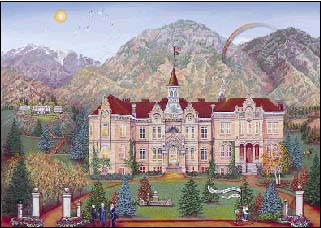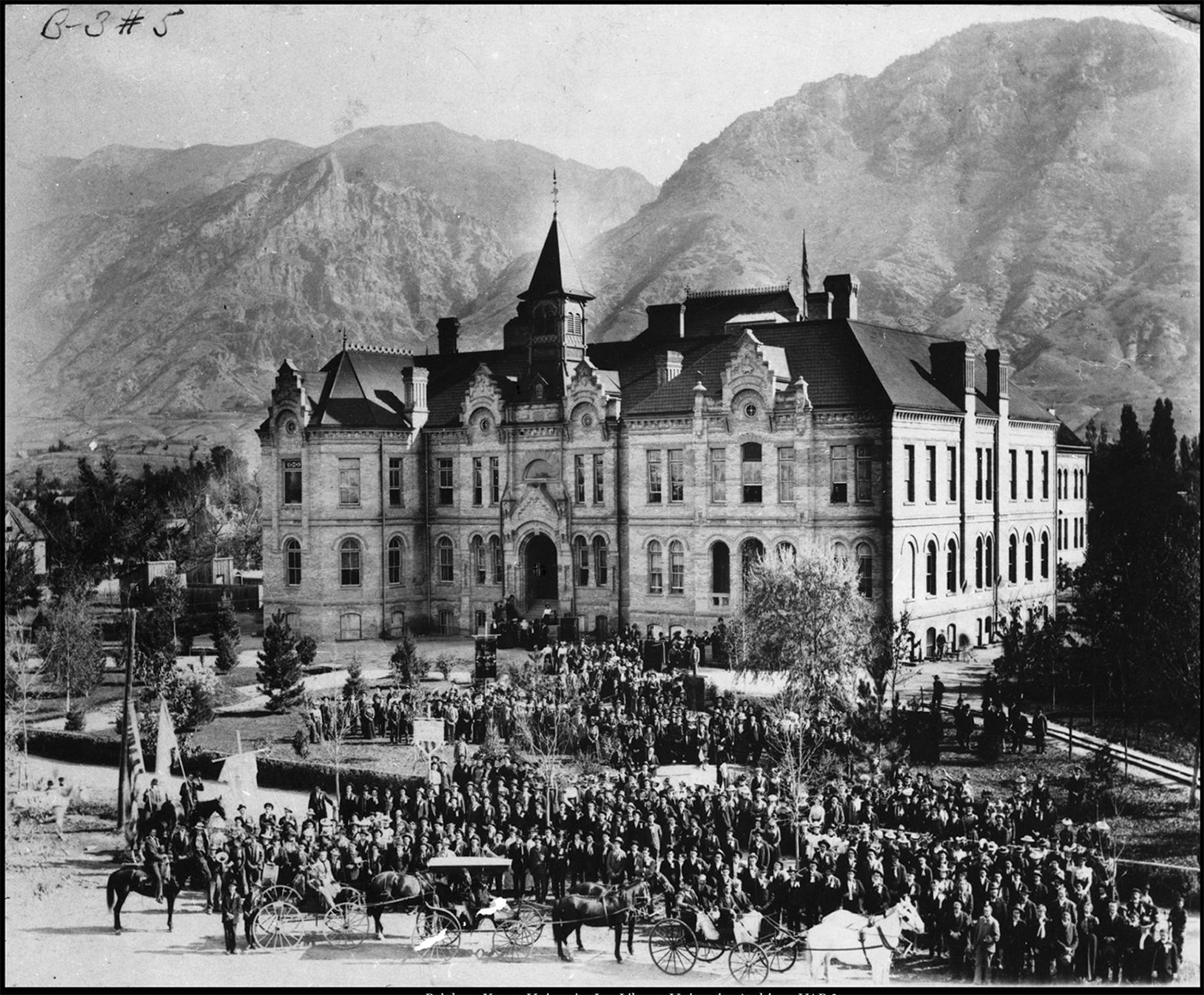By Jeff McClellan
When Utah artist Jacque Baker stumbled onto the Brigham Young Academy Education Building in August 1995, she had no idea her talents would become a part of the latest–and perhaps last–effort to save the 104 year-old structure.
Baker was in Provo to sign prints of her Utah centennial painting during Education Week, and while driving around she happened upon the Academy -“a beautiful old woman that needed her face lifted and then could be gorgeous again,” she says. Sitting on the beehive fountain in front of the Academy, the artist looked at the building and cried.
“I have a heart for old buildings,” says Baker, who spent several years buying and restoring old homes, including the 120-year-old Victorian in Santa Cruz, Calif., that she still owns.
About 10 years ago, Baker turned her creative efforts from restoring buildings to painting. In her art, she combines her love of architecture with her years of needlepoint to create a style that has grabbed the attention of many, including Clint Eastwood, a Japanese amusement park, and Pebble Beach Resort.
Baker’s works often focus on historical landmarks, so when she found the Academy, it was only natural to begin work on a painting.
“I didn’t know why I was painting it,” Baker says. “I just knew that I loved that building.”
As she began researching the Academy, she soon found herself talking to the great-grandson of Abraham O. Smoot, the “financial father” of Brigham Young Academy. Besides being A.O. Smoot’s descendant, L. Douglas Smoot is the former dean of BYU’s College of Engineering and Technology and just happens to be heading up the most recent effort to save the Academy.
Sold by BYU in 1975, the Academy has spent the last 20 years bouncing between various owners who have tried to make something of the four buildings, which weather and vandalism have slowly deteriorated.
In 1994, Provo City bought the block, but a preservation easement prevented the buildings from being torn down. Now the city is embroiled in a legal battle to have the easement annulled.
Smoot, however, is leading a major effort to convince the city that the Academy–or at least part of it–can be saved. When he and Baker met, the two collaborated their efforts.
“The building deserves to be saved,” says Baker of the Education Building, the main Academy building. Baker delved into books, pictures, archives, and interviews to research the Academy. “A lot of old buildings do not deserve to be saved. This one not only is a beautiful old building, but it has history–history that’s pertinent and relevant to the town and the university and the Church.”
Baker shares that history through her painting, which includes the wooden stairs that led to Upper Campus in the early 1900s, the Y on the mountain, and many other minute details, including the state bird, tree, animal, flower, and flag.
She also painted the birch trees planted by two young daughters of an early Academy leader.
“One tree was to be planted on either side of the entrance to the Academy,” Baker says. But when the youngest daughter learned her tree wouldn’t be next to her sister’s, she began to cry. “So they ended up planting both birch trees side-by-side.”
The painting features the Education Building and the first three buildings of Upper Campus. Sitting on the beehive fountain is Joseph Don Carlos Young, the Education Building’s architect, and on the street are Brigham Young, Karl G. Maeser, and Abraham O. Smoot.
“Abraham Smoot spent his entire fortune saving this building,” Baker says, “and he was such an admirable man–a human dynamo.”
A.O. Smoot was the first president of the Brigham Young Academy Board of Trustees, from 1875 until his death in 1895. A successful entrepreneur and Church leader, Smoot sustained the academy through those difficult early years. When he died, much of his estate was sold to pay the many personal notes he had signed to build the building and to keep the Academy afloat.
Smoot’s great-grandson discovered his ancestor’s legacy while writing a book on him. “Having seen A.O. Smoot’s efforts gave me another incentive to try to save the Academy. I love Provo and this university, and that was already enough incentive.”
To save the Academy, Doug Smoot realized two things: The building must be used for a public purpose, and it must be a purpose the city needs and will help pay for.
Smoot found his project in the Provo City Library, which is in need of a larger facility. To pay for a new or expanded library, the city has planned to spend $4 million–$4 million Smoot would like to see used to help renovate the Academy to be the library’s new home.
To prove such a renovation is possible, the BY Academy Foundation has raised $50,000 for an extensive feasibility study. Designed with help from the city council and the library board, the study is examining the Education Building and College Hall to determine if the buildings can “measure up to some very exacting requirements to be an ultra-modern, high-tech library,” Smoot says.
The study is scheduled to be finished by March 16. If the results indicate such a renovation is feasible, Smoot will go before the library board and the city council in April to present his case.
If the project is approved, Provo City voters must authorize a $4 million bond, and Smoot and the Academy Foundation must raise the rest of the estimated $10–12 million required for renovation.
“The money’s out there,” says Shirley Paxman, secretary-treasurer of the foundation. “People love those buildings. All over the United States people love them, and the money’s there.”
And that’s where Baker and her painting come into the plan. Prints of the painting will sell for $40, or $70 with Baker’s signature, to raise funds for the project. The BYU Alumni Association is helping to sell the prints, but Smoot emphasizes that the Alumni Association will retain the proceeds until the project is approved by the city. If the effort fails, the funds will go to the Alumni Association’s Replenishment Grant Scholarship Fund.
Having been involved with nearly every effort to save the Academy over the past 20 years, Paxman sees real promise in the library project because there is community support.
Smoot agrees. “One of the nice things about this project is there’s broad cooperation and participation with Provo City and the citizens and the BY Academy Foundation.”
“All it takes is money and time,” Baker says. “And money is nothing. Money will be spent on far-less-worthy projects.”









